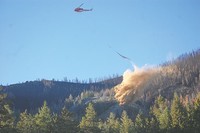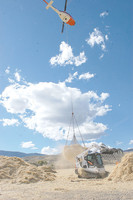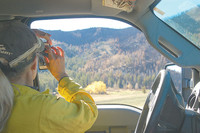Mostly Clear, 46° F
The straw drifts down like flaxen confetti at a New Year celebration. Some of it is powdery, while larger shreds approximate autumn leaves dodging a homeowner’s rake. Then Orr is gone, heading back to fetch another load at the staging area above …
This item is available in full to subscribers.
The Powell Tribune has expanded its online content. To continue reading, you will need to either log in to your subscriber account, or purchase a subscription.
If you are a current print subscriber, you can set up a free web account by clicking here.
If you already have a web account, but need to reset it, you can do so by clicking here.
If you would like to purchase a subscription click here.
Please log in to continue |
|




Tump, thump, thump.
The helicopter proclaims its approach, appearing in the distance like a fly speck on a windshield. An instant, later the big comely aircraft is circling the rugged hills of fire-tinged trees like a bed of rusty nails. Its cargo is a gigantic net of loose straw tethered to a cable. Pilot Andy Orr of AV8-Orr Helicopters, Hamilton, Montana, releases his load.
The straw drifts down like flaxen confetti at a New Year celebration. Some of it is powdery, while larger shreds approximate autumn leaves dodging a homeowner’s rake. Then Orr is gone, heading back to fetch another load at the staging area above Gary Cooper’s ranch on Stage Coach Trail.
Orr has been hired by the Bureau of Land Management to drop loads of straw onto some of the terrain burned by this summer’s Whit Fire, west of Cody.
The “straw bale bombing” started Saturday and is aimed at mitigating erosion in the wake of the fire.
Straw prevents erosion by helping soil soak up rain or snow more readily in a big rain storm or if snow melts fast, said Shauna Jensen, San Juan National Forest hydrologist in Dolores, Colorado, and U.S. Department of Interior Burn Area Emergency Response Team member.
Jensen visited the post-fire site to offer recommendations.
On Saturday, a fine haze hangs in the air like a lovely tawny fog that will surely dissipate with the sun’s warming rays.
“It’s almost like a blanket of yellow snow,” said Patricia Hatle, bureau range/wild horse specialist overseeing the operation.
To loosen the load, the straw bales are broken and fluffed up, Orr said. Then 2,000 to 2,500 pounds of the certified weed-free straw is piled in a net for helicopter transport to the burn areas.
A total of 240 large bales from 10 tractor-trailers will be dispersed over the burn, Orr said. The operation will take three to four days.
He flies about 40 knots (46 mph) at 200 or 300 feet above the ground, Orr said. “And that gives a nice distribution.”
Ground support
Two bustling skid loaders break up and loosen the big bales creating mountains of straw for the nets. It shines in the sun like prodigious piles of luxuriant blond hair lying on a salon floor.
“Never a dull moment,” said Orr employee Armon Meis.
Meis hops in his loader to fluff and dump the straw on nets for helicopter pickup. “Six-minute turnaround,” Meis said. “A lot to do in six minutes.”
As though being timed, the helicopter burst from the hills like a giant hummingbird, demanding another load. Hovering over the loading zone, the machine kicks up a backwash, stirring a ground blizzard of chaff.
“Here we go again,” Meis said.
Straw survey
Matt Schaland, the BLM’s incident commander on Whit, and his crew hike above the Ballinger ranch in the forest of burned snags. The yellow carpet of straw juxtaposes perfectly with the blackened trees.
After the pilot departs to bomb another grid, Schaland examines Orr’s handiwork.
“We need at least a one-quarter (inch) to 2-inch max,” Schaland said. They are measuring every 100 feet of the 25- to 30-acre grid to calculate the straw depth average. The average is 1 inch.
“Perfect,” Schaland says.
Risk model
Jensen’s computer model tells where red flag areas are in the Whit Fire watershed. It indicates the values at risk, such as buildings and roads.
If there’s a 10-year rain event — the kind of heavy rain that occurs once every decade on average — 1.35 inches of rain would fall in six hours; approximately six private residences would be at risk of being entered by mud and debris, threatening safety, Jensen said. Those spots were considered high priority for the straw bale bombing, she said. Of course, Jensen added, a downpour of 1.35 inches could happen any time.
Planned rehab
Grass seed is also part of rehabilitation.
Orr has an aerial seeder that packs 600 pounds of seed per load to spread a 40 to 45 foot swath, he said. A GPS device on his ship tells him where he’s been. “The technology is pretty advanced.”
Jensen recommended seeding on barren slopes. She prescribed straw in areas with trees where the wind is less likely to carry it away, she said.
The focus is locations of moderate to severe burning, Jensen said. Less burn severity leaves root crowns and organic litter that will aid precipitation infiltration. High burn severity leaves barren ground, precipitating greater runoff.
Straw promotes the infiltration of rain/snow, Jensen said. In the long term the straw, acting as a mulch will insulate seeds and retain moisture thus improving germination, just like a backyard garden. Quick germination creates sod. “That improves (water) infiltration.”
The straw also will aid penetration during spring snowmelt, Jensen said.
Additional seeding is planned for next year, said Delissa Minnick, Cody bureau field manager.
Total rehabilitation, including federal emergency funding, is just under $1 million, Minnick said.
Range improvement projects include stock tanks, pipelines and fencing lost to the fire and grass seeding, she said.
Whit burned 12,387 acres, according to InciWeb.
That’s a big fire by the BLM’s standards in Wyoming, Minnick said.
The bureau does not rehabilitate private property, but the Park County Commission is sponsoring a program that could bring federal funding to help restore private land.
Support
Although she felt bad hampering hunting season’s opening day with noise, it was the bureau’s only opportunity to schedule the helicopter contractor, Minnick said.
Area landowners and recreationists have been very supportive of the bureau’s efforts to rehabilitate the post-fire land, she said. “It’s been a wonderful cooperative effort.”
Tracks left by fire suppression equipment needs time to heal, Minnick said. The off-road-vehicle and hunting community has been very helpful educating their colleagues to steer clear of fire equipment trails, Minnick said.
Sheep Mountain provides access to hunters and hikers, Minnick said. “It’s a very special place.”